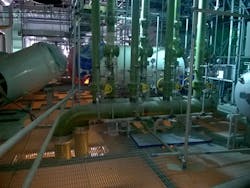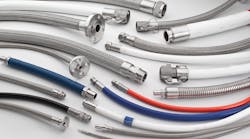Flow-induced vibration is a serious risk to piping systems, and it is usually under-estimated and overlooked. Based on some observations in modern plants and facilities, more than 25% of piping failures were due to piping vibration and associated fatigue. A key factor is, while many piping systems have been thoroughly checked for stresses, reaction loads and other aspects of operation, they usually have not been checked for the possibility of flow-induced vibration. This is a shortfall in modern piping and fluid movement industries.
Flow-related vibration of the piping systems is a common cause of high-cycle fatigue in piping of plants and facilities. Failures of piping systems due to flow-induced vibration or other types of flow-related vibration have been one of the major causes of unscheduled shutdown, downtime, fires and explosions. However, the challenge of flow-induced vibration did not receive a consistent or required level of attention to ensure both safety and reliability of piping systems.
This article focuses on practical notes and useful technical guidelines on flow-induced vibration.
Background
Fluid structure interactions due to internal fluid flows are common sources of problems, issues and even failures. Turbulent flows are known to sometimes generate significant levels of excitations and consequently, vibrations of the piping and associated structures. Piping systems, valves, some devices and inlines can generate strong vibrations, transient pulses, cavitation effects and various types of flow instabilities. There have been many different forms of such problems including turbulence-induced vibrations, fluid hammer, different types of vortex shedding, cavitation-induced vibrations and others.
The study of flow-induced vibration of piping in the general form involves the coupling of fluid dynamics and piping structural vibration. The problem is complicated, challenging and highly nonlinear in nature. It is of great practical importance to many piping systems, especially whenever this flow-induced vibration can lead to excessive vibration, operational problems, fatigue and failure.
Flow-induced vibration
Flow-induced vibration affecting piping systems has been a phenomenon for several decades. It is sometimes referred to as turbulence-induced vibration. Flow-induced vibration has often affected small bore piping connections.
Each type of flow-induced vibration can be described and analyzed as different independent flow-related vibration phenomena. These can be caused by a number of mechanisms such as:
Rapid changes in flow conditions or fluid properties caused by opening valves, cavitation or large pressure variations leading to changes in fluid conditions. A well-known example is those produced by pressure-reducing devices.
Fluctuating flow past obstructions or objects in the flow, for example, tees, piping fittings, thermowells or other intrusions in the flow.
Simplified physics
The following is a simplified version of the physics involved in flow-induced vibration. The roughness of the piping wall causes the friction between the fluid particles and inside the piping. Due to the friction, the flow velocity is decreased, and the pressure drop is increased. The flowing fluid will reduce its velocity because of the roughness, which could be described as very tiny ridges and valleys present on the inside surface of the piping. The ridges and valleys oppose the motion of fluid particles. The fluid particles, which are flowing near the wall surface, are affected. The process in the microscopic level could be imagined as each and every ridge and valley oppose the motion of fluid particles, resulting in three-dimensional excitation forces on the piping; consequently, this can cause the vibration of the piping. This is over-simplified physics to show how flow-induced vibration is developed in typical piping.
Natural frequencies and modes
Every piping system has the tendency to vibrate at certain frequencies, called natural frequencies. Every natural frequency is associated with a definite and unique shape, called mode shape, which the replica dynamic deformation will assume when vibrating at the frequency. The natural frequencies and modes depend on the distribution of mass and stiffness throughout the piping system, and the distribution is influenced by piping diameter, material properties, wall thickness, location of lumped masses (such as valves), piping supports and fluid density. A mode shape has the locations of zero motion (node) and maximum motion (anti-nodes). The response of the piping to an applied excitation depends on the relationship between the frequency and pattern of the excitation and the piping system’s natural frequencies/modes. When a piping system is excited by a dynamic excitation with a frequency that coincides with one of its natural frequencies, the system undergoes great displacements and stresses. This phenomenon is known as resonance, and it can cause high vibration, even fatigue, and subsequently, failure. Vibration generated in the piping work may lead to high-cycle fatigue of components, such as small-bore connections, or the failure at welds in the main piping itself.
Flow-induced vibration: Phenomenon and key parameters
Flow-induced vibration is usually a low-frequency phenomenon caused by high flow velocities and turbulence at discontinuities in the piping (branch connections, bends and similar) that excite low-frequency bending modes in the piping.
Flow-induced vibration is driven by flow velocity. A key parameter is the dynamic pressure, which is density multiplied by square of velocity (ρv2). This induced vibration is usually from turbulent mixing with boundary layer separation and pressure pulsations at piping discontinuities (bends, tees, reducers, etc.). This leads to shaking forces at these piping discontinuities that generate low frequency (usually below 30 Hz) vibration, and often longitudinal beam modes, in the piping with visible piping movement or shaking. This tends to affect smaller diameter, low natural frequency piping systems, particularly vent systems, flare systems or similar.
Modern screening criteria to initially assess the potential and possibility of flow-induced vibration is based on dynamic pressure (ρv2) together with factors that consider piping diameter, wall thickness and a range of piping flexibility.
Beam mode versus shell mode
There is a risk of flow-induced vibration for relatively thin-walled piping subjected to flows with relatively high velocity. It is well-known that flow-induced vibration occurs at locations where high turbulence is present, such as downstream of a combining tee, pressure-reducing device, etc. However, the type of excitation depends on the piping system. Flow-induced vibration usually initiates beam mode vibration. In other words, for small diameter piping, the beam mode vibration constitutes the lowest natural frequency mode, and then this mode is expected to be excited first. For thin-walled large-diameter piping, the shell mode vibration of the piping might present lower natural frequency than the one of the beam mode vibration. Then, the shell mode might be excited first. In some cases of thin-walled large-diameter piping, the turbulence generated at the flow turbulence section creates the large pressure fluctuation and leads to shell mode vibration.
High velocity flows and acoustic-induced vibration
Acoustic-induced vibration is generated by turbulence and shock waves immediately downstream of a high flow rate, high pressure drop, pressure-reduction device or similar situations where turbulence and shock waves exist. This generates high frequency circumferential vibration in the piping. The generated circumferential vibration usually has no visible piping movement. This vibration can lead to fatigue failures at asymmetric piping discontinuities such as branch connections and welded pipe supports.
Pressure-reducing devices, such as relief valves, control valves and orifice plates, can generate high-velocity flows downstream. The sound power level is a function of the pressure drop across the device, the upstream pressure, the mass flow through it, the molecular weight and the temperature. This acoustical energy propagates downstream of the valve or device where the resulting vibration can cause failures due to fatigue — sometimes, in just a few hours or days of operation.
Acoustic-induced vibration is driven by flow rate and pressure drop and tends to affect large-capacity relief, depressuring and blowdown systems. The acoustic energy in this immediate area near the pressure-reduction device is due to an intense nonpropagating sound field (turbulence and shock waves). This sound field decays with distance, nominally in the length of around 10 diameters, and results in acoustic energy propagating down the piping as a plane wave together with higher order modes.
The acoustic energy can excite the high-frequency circumferential-mode vibration, affecting asymmetric discontinuities in the piping such as branch connections, small bore connections and welded piping supports. These asymmetric discontinuities also act as points of stress intensification for this shell mode vibration.
Usually, the first branch connection downstream of the pressure-reducing device is seriously affected by this excitation. Too often, this is the discharge lead connection to sub-header or header. This effect can be further compounded by the potential for additional flow-related excitations, emphasizing the risk and importance of adequate reinforcement for this first branch connection after the device.
Recommendations and solutions
In cases where a piping system is prone to flow-induced vibration, there are a few options to solve or mitigate such a problem. The final goal is to eliminate the frequency match between the flow-induced excitation frequency and the piping natural frequency. One way is to increase the diameter of the piping, which in turn, increases the weight and cost of the whole system. The second option is a better support configuration for the piping. The latter solution is usually preferred because it does not produce any change in the operational parameters of the piping, and the additional cost is usually low. For instance, a piping section with two-support can be improved to a three-support system to solve such a problem.
For another example, when appropriate, all piping supports should be U-bolts, clamps or similar with full circumferential bands. This leads to more rigid piping and an increase of the natural frequency of the first mode and other modes of the piping section. Therefore, the natural frequency can be moved well above the excitation frequency. However, care should be taken with these approaches. Some degree of flexibility is always needed for any piping to deal with thermal movements.
The aforementioned solutions — and generally, many modern guidelines to deal with flow-induced vibration — point toward increasing piping stiffness to reduce the likelihood of dynamic problems and failures. However, care should be taken with this approach to ensure that the impact on thermal stresses is also considered. A stiff piping system with less flexibility using many supports or restrictive support scheme (such as U-bolts, clamps, etc.) may offer high natural frequency and a far less possibility of flow-induced vibration, but thermal stresses and reaction loads might be high, even exceeding the limits. Therefore, optimization is required.
Another recommendation to mitigate some risks of flow-induced vibration in small bore piping systems has been to increase the piping wall thickness. The increased stiffness and stress reduction, resulting from increasing the wall thickness, are usually beneficial in terms of stiffness, stress or local reinforcement. As a rough indication, doubling the wall thickness decreases the stress by a nominal factor of two. However, there may be hesitancy to include the heavier walled piping because of the increased cost.
Typically, the ratio of diameter to thickness (D/t) should be reduced in high-energy piping systems, although it is difficult to note numerical values for this ratio. Some experts suggest D/t2 is a better measure for the comparison and assessment.
Amin Almasi is a lead mechanical engineer in Australia. He is a chartered professional engineer of Engineers Australia (MIEAust CPEng – Mechanical) and IMechE (CEng MIMechE) in addition to a M.Sc. and B.Sc. in mechanical engineering and RPEQ (Registered Professional Engineer in Queensland). He specializes in mechanical equipment and machineries including centrifugal, screw and reciprocating compressors, gas turbines, steam turbines, engines, pumps, condition monitoring, reliability, as well as fire protection, power generation, water treatment, material handling and others. Almasi is an active member of Engineers Australia, IMechE, ASME and SPE. He has authored more than 150 papers and articles dealing with rotating equipment, condition monitoring, fire protection, power generation, water treatment, material handling and reliability. He can be reached at [email protected].



